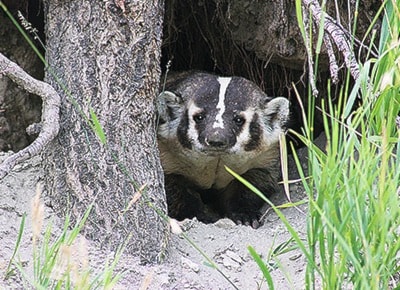Why are badgers at risk?
The badger is at risk in British Columbia due to fragmented and threatened habitat, low reproductive success and high mortality.
Badger habitat is limited primarily to the dry, southern interior of the province.
The key habitats for badgers – grasslands and open pine or fir forests along the major valleys – have been greatly modified by development of towns, rural subdivisions, ranches, orchards, golf courses and highways.
Many former habitats, particularly in the Okanagan area, no longer support badgers. Reservoir flooding in the East Kootenay area has removed badger habitat. Forest succession and encroachment into grasslands is reducing available habitat in some regions, although some habitat has been created in areas where productive forests have been cleared for agriculture.
From settlement times until quite recently, Badgers received little or no protection. Many were trapped for their fur or were indiscriminately shot as nuisance animals. Ranchers feared that their cattle or horses would break a leg by stepping in badger burrows, or that badger digging would damage irrigation works and interfere with operation of farm machinery. Although damage by badgers is usually not serious, it has resulted in considerable persecution.
Rodent control programs, that poisoned ground squirrels and pocket gophers, probably reduced the food supply for Badgers and resulted in deaths of some that ate poisoned rodents.
These historical factors, in combination, are believed to have seriously reduced badger populations in the province.
Today, trapping and sport hunting of badgers are not allowed, rodent poisoning is not practised on Crown Lands, and removal of badgers that cause property damage is strongly discouraged.
Nevertheless, badgers are probably still illegally killed each year, or caught in traps set legally for coyotes or bobcats.
In addition, badgers are now faced with hazards such as getting caught in fences, drowning in irrigation canals or being run over by vehicles or trains.
Highway traffic is presently the major cause of badger mortality in British Columbia.
Human activities here may result in relatively few badger deaths each year, but it must be remembered that the population is already small. Mortality caused directly or indirectly by people, when added to natural losses, could be preventing population increase or causing continued declines in some areas.
Continuing development in badger habitats across the province for housing, agriculture and other uses is a major concern, particularly in the Okanagan Valley, but also in the Thompson River and Rocky Mountain Trench areas. As land development continues, badger populations will be further reduced.
Very little badger habitat is protected in parks or reserves.
Badgers are very difficult to count and intensive monitoring of the B.C. population has only recently begun.
Present estimates of their abundance are based on radio-telemetry studies in the East Kootenay and Thompson-Okanagan regions, as well as on random sightings, digging sign, specimen records, such as from traffic kills, and local knowledge of wildlife biologists and other field workers. Badger populations are difficult to census because badgers are nocturnal and can have very large home ranges, and because there appears to be no direct correlation between the number of badger burrows in an area and the number of badgers.
Analysis of historical information suggests that there are fewer badgers in B.C. now than a century ago. A recent review of Badger abundance in B.C. concluded that the population is less than 200 breeding adults. This small population, spread thinly over several valleys, is extremely vulnerable to regional and provincial extirpation due to further human development in the key habitat areas.
Badgers eat large numbers of rodents that may damage pastures or cropland and compete with livestock for forage.
Studies of captive badgers have estimated that they need about 2.3 ground squirrels [gophers] per day to meet their energy needs. Badgers in the wild could be expected to severely reduce rodent numbers based on badger population density.
Badgers are largely solitary and nocturnal in their habits. In B.C., where suitable habitats have a patchy distribution, home ranges for females average 50 square km, while for males they can reach up to 500 square km. Home ranges of individuals often overlap and there is no evidence of defended territories.
In winter, Badgers confine their activities to a small part of their total home range.
The badger was originally placed on the provincial Blue List of species vulnerable to human activity, but new information resulting from recent research in the Kootenays and in Thompson-Okanagan resulted in moving this species to the Red List (species being considered for legal designation as Threatened or Endangered). Nationally, the Committee on the Status of Endangered Wildlife in Canada (COSEWIC) considers the British Columbia subspecies of badger to be Endangered.
Since 1967, it has been illegal to trap or shoot badgers anywhere in B.C. It is also illegal to buy or sell badger pelts, and any badgers killed accidentally must be reported to a Conservation Officer.
For more badger information you can go to:
http://www.env.gov.bc.ca/wld/documents/badger.pdf
http://www.env.gov.bc.ca/wld/documents/recovery/rcvrystrat/badger_jeffersonii_rcvry_strat18092008.pdf
http://badgers.bc.ca
Article information courtesy of British Columbia Ministry of Water, Land and Air Protection
